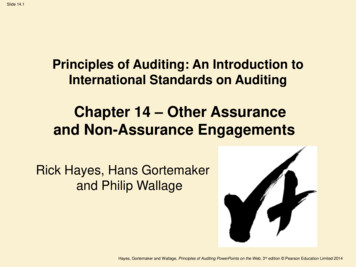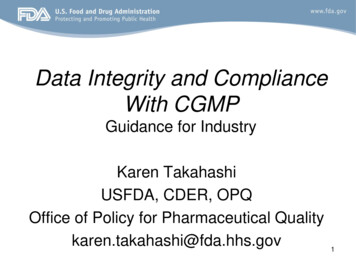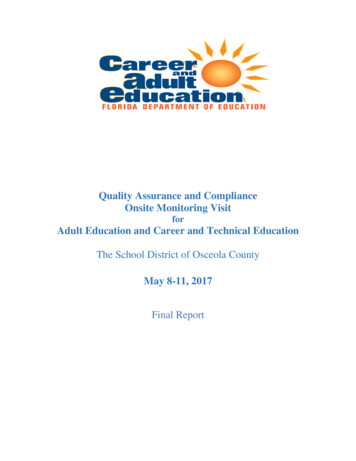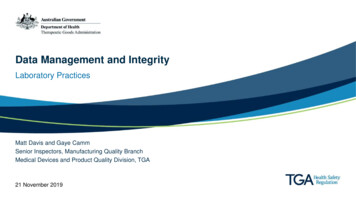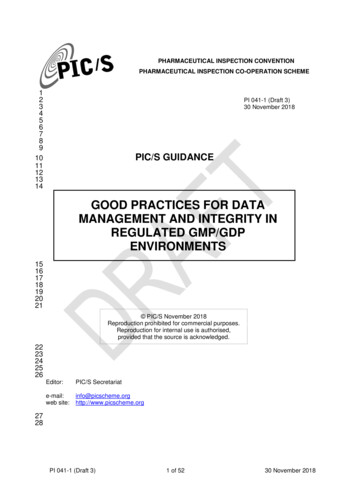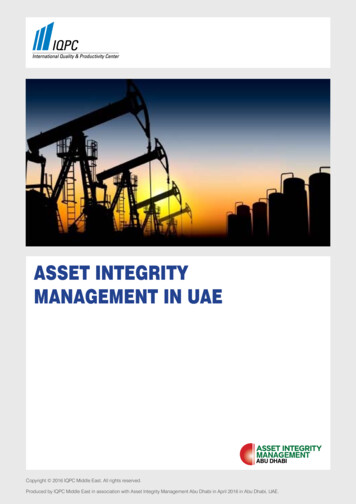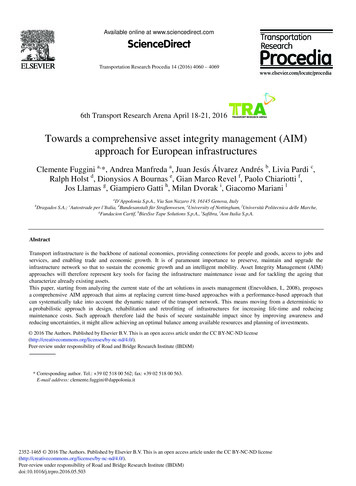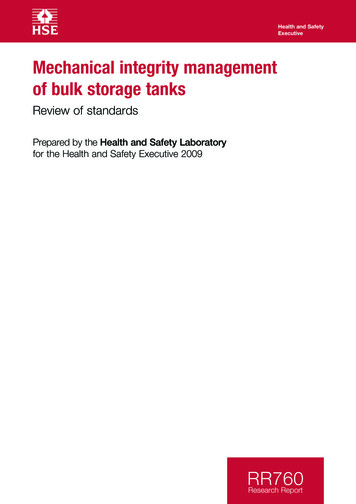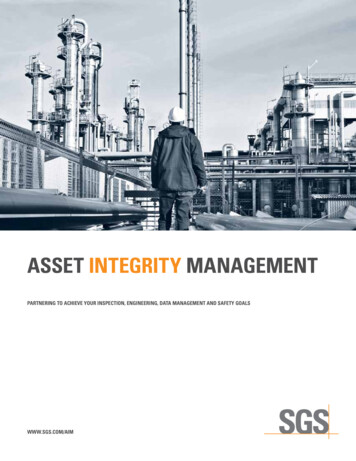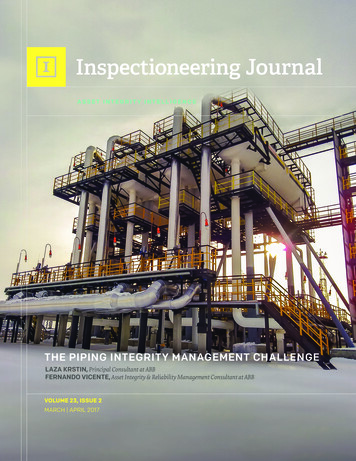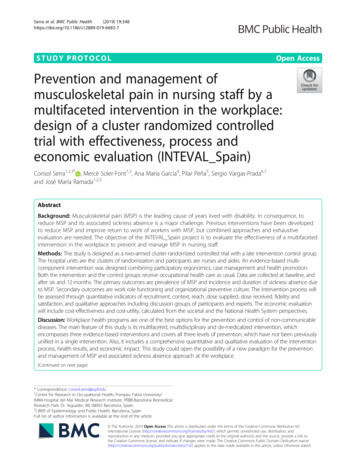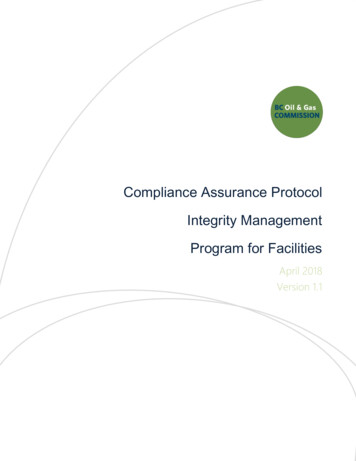
Transcription
Compliance Assurance ProtocolIntegrity ManagementProgram for FacilitiesApril 2018Version 1.1
Compliance Assurance Protocol Integrity Management Program for FacilitiesTable of ContentsINTRODUCTION . 5Regulatory Standards and References. 7Flexibility and Scalability . 9Terminology . 9Safety Culture. 10Compliance Assurance Process. 10Phase One. 12Phase Two. 12Phase Three . 13Framework. 13Expectations and Requirements. 131.0 LEADERSHIP COMMITMENT . 171.1General IMPF . 171.2Policy and Leadership Commitment. 181.3Goals, Objectives and Targets. 181.4Planning. 182.0 RISK ASSESSMENT AND MANAGEMENT . 192.1 Process Knowledge and Information . 192.2 Hazard Identification . 21Page: 2BC Oil and Gas CommissionUncontrolled copy once downloadedVersion 1.1published: April 2018
Compliance Assurance Protocol Integrity Management Program for Facilities2.2.1 Facility Projects. 212.2.2 Process Operations . 222.3 Risk Assessment. 222.4 Risk Tolerance . 222.5 Risk Reduction and Management . 232.6 Risk Review and Update . 232.6.1 Risk Assessment and Review. 232.6.2 Risk Management Review . 243.0 ORGANIZATIONAL STRUCTURE, ROLES AND RESPONSIBILITIES . 254.0 COMMUNICATION PROCESS . 265.0 TRAINING AND COMPETENCY . 276.0 INFORMATION MANAGEMENT DOCUMENTS AND RECORDS CONTROL . 287.0 MANAGING CHANGE . 298.0 OPERATIONAL CONTROLS . 319.0 INSPECTION, MONITORING AND MAINTENANCE . 3210.0 EVALUATION AND FITNESS - FOR - SERVICE ASSESSMENT . 3311.0 MODIFICATION AND REPAIR . 3412.0 INCIDENT / NEAR-MISS INVESTIGATION AND LEARNING . 35Page: 3BC Oil and Gas CommissionUncontrolled copy once downloadedVersion 1.1published: April 2018
Compliance Assurance Protocol Integrity Management Program for Facilities13.0 PERFORMANCE MEASUREMENT AND ANALYSIS OF DATA . 3614.0 AUDIT . 3915.0 MANAGEMENT REVIEW . 40Page: 4BC Oil and Gas CommissionUncontrolled copy once downloadedVersion 1.1published: April 2018
Compliance Assurance Protocol Integrity Management Program for FacilitiesIntroductionPermit holders of oil and gas facilities under the British Columbia Oil and Gas Commission’s (Commission)jurisdiction are required to have a management system based asset-integrity protection program for anticipating,preventing and mitigating hazards and risks of and around their permitted facilities not to affect safety andenvironment adversely. An Integrity Management Program (IMP) – a preventive documented framework,consisting of a systematic, comprehensive, and proactive set of interrelated processes, enables effectivemanagement of asset integrity associated with activities throughout the life cycle of the asset, including design,procurement, construction, operation, maintenance and abandonment activities.Permit holders’ integrity management program for facilities (IMPF) must include policies, processes andprocedures to: Set relevant company policies and performance objectives, Proactively identify hazards associated with process, various types of equipment and componentsof the facility, controls, and humans, and evaluate risks to people, environment, and the asset, Manage the asset risk, through identification and implementation of risk mitigation measures,including conducting inspection, maintenance, and monitoring activities, Establish clearresponsibilities and accountabilities, Have trained and competent personnel, and, Manage documentation, reporting, evaluation and continual improvement.The purpose of this protocol is to provide guidance to facility owners and operators outlining the Commission’srequirements and expectations with regards to developing, implementing and maintaining an integritymanagement program for facilities (IMPF). This will: Ensure safe, environmentally responsible, and reliable operation, and, Manage the risks over the entire lifecycle, i.e., planning, design, construction, operation,maintenance, and decommissioning stages.The requirements and expectations within this compliance assurance protocol apply to all types of facility assetsowned and operated by the permit holder within the jurisdiction of Commission, such as, well pads, gas plants,compressor stations, pumping stations, disposal stations, batteries, and LNG plants. Figure 1 is a non-exhaustivelist of facilities regulated by the Commission and covered under this IMPF protocol. The protocol makes provisionPage: 5BC Oil and Gas CommissionUncontrolled copy once downloadedVersion 1.1published: April 2018
Compliance Assurance Protocol Integrity Management Program for Facilitiesfor inclusion of facilities, such as, manufacturing plants or petroleum refineries, once the Commission has aregulation in place for these types of facilities.The IMPF requirements also apply to all third-party operated facility assets licensed to a permit holder.Figure 1: Types of Facilities Covered by the IMPFPage: 6BC Oil and Gas CommissionUncontrolled copy once downloadedVersion 1.1published: April 2018
Compliance Assurance Protocol Integrity Management Program for FacilitiesRegulatory Standards and ReferencesThe regulatory requirements for IMPF are based on the following Acts, Regulations, and Standards. Part 1 of the BC Oil and Gas Activities Act (OGAA)1 defines “Pipeline” as piping through whichpetroleum, natural gas, or produced water, etc. is conveyed and includes installations and facilitiesassociated with the piping. Section 7 (c) of BC Pipeline Regulation (PR) 2 requires a pipeline to beoperated in accordance with a pipeline integrity management program. Section 3 of PR states that a pipeline permit holder must design, construct, operate or maintain apumping station, compressor station, or an oil storage tank associated with a pipeline in accordancewith CSA Z6623. The Drilling & Production Regulation (DPR)4 states:ooo In section 78.1, that a facility permit holder must prepare and maintain an integrity managementprogram and carry out operations in accordance with the integrity management programthroughout the life cycle of the facility. (Effective June 15, 2018).In section 78, that a facility permit holder must operate and maintain the facility piping system inaccordance with CSA Z662, if it is designed and constructed in accordance with that standard.In section 50, that a permit holder must take every reasonable precaution to prevent loss orwaste of oil, gas or water in drilling, producing and processing operations, and, in storing, pipingor distributing, oil or gas must not be used wastefully or allowed to leak or escape from naturalreservoirs, wells, tanks, containers or pipes.Oil and Gas Pipeline Systems standard, CSA Z662 Clauses that outline IMPF are defined below:oooClause 2.2 of CSA Z662-15 defines ‘Pipeline System’ as ‘pipelines, stations, and other facilitiesrequired for the measurements, processing, storage, gathering, transportation, and distributionof oil & gas industry fluids’.Clause 3.2 of CSA Z662-15 on ‘Pipeline System Integrity Management Program’ states thatoperational controls required by Clause 3.1.2 (f) (v) shall be in the form of an integritymanagement program.As per the Clause 9.1.5 of CSA Z662-15, operating companies shall inspect piping exposed tothe atmosphere at the intervals as per their operating and maintenance (O&M) manuals. If thereis vibrating service present, inspection of welds for cracks, particularly at points of restraintswhere piping is attached to equipment and near anchors, shall be carried out as per their O&Mmanuals.1 BC Oil and Gas Activities Act (OGAA), 2015.2 BC Pipeline Regulation (PR), 2014.3 CSA Z662, Oil & Gas Pipeline Systems, 2015.4 Amendments to the BC Drilling & Production Regulation (DPR), 2015.Page: 7BC Oil and Gas CommissionUncontrolled copy once downloadedVersion 1.1published: April 2018
Compliance Assurance Protocol Integrity Management Program for Facilitiesoooo The Commission’s Liquefied Natural Gas Facility Regulation (LNGFR) requirements are definedbelow:oo Clause 10.5 of CSA Z662-15 states that operating companies shall operate and maintain theirpipeline systems (that include associated facilities as per the CSA Z662 definition of ‘pipelinesystem’) in accordance with documented procedures that meet requirements of Clause10.5.1.2.Clause 10.9 of CSA Z662-15 stipulates operational and maintenance requirements forcompressor and pump stations, above ground tanks and pressure vessels, undergroundstorage, pipe-type storage vessels, pressure control, pressure-limiting and pressure relievingsystems, valves, and vaults. The clause also makes reference to various standards, such as,API 5105, API RP 5726, API RP 5767, API 6538, API 26109 and CSA B5110 for relevantguidance.Clauses 10.9.2.1, 10.9.3.1, 10.9.3.2 and 10.9.6.2 of CSA Z662-15, operating companies arerequired to carry out scheduled inspections, as a minimum, for the following type of facilities:above ground steel tanks, underground storage tank, underground pipe for the storage, andpipeline valves.Secondary containment for above ground tanks shall be inspected periodically and maintainedin accordance with Clause 10.9.2.5 of CSA Z662.Section 8 and Section 22 of LNGFR11 requires an LNG facility permit holder to develop andimplement an Integrity Management Program, in accordance with CSA Z276-1512,Subsection 3(1)(d) of the LNGFR requires the permit holder to establish facility hazards throughhazard identification study as well as carry out a process hazard analysis and a safety integritystudy prior to construction of the facility.The IMPF requirements for LNG facilities based on CSA Standard Z276 are outlined below:ooClause 13.2 of CSA Z276 states that each operating company of an LNG facility shall havedocumented operation and maintenance procedures and a training program based onexperience, its knowledge of its LNG plants, and the conditions under which the procedures willbe used. Clauses 13.2 to 13.6 of the standard contains requirements, including minimumstandards, for the safe operation and maintenance of LNG plants and for personnel training,Clause 13.4.1.2 of CSA Z276 states that operating companies shall carry out periodicinspections or tests, or both as required, with generally accepted engineering practices and as5 API 510, Pressure Vessel Inspection Code: In-service Inspection, Rating, Repair and Alteration, 2014.6 API RP 572, Inspection of Pressure Vessels, 2009.7 API RP 576, Inspection of Pressure-relieving Devices, 2009.8 API 653, Tank Inspection, Repair, Alteration, and Reconstruction, 2014.9 API 2610, Design, Construction, Operation, Maintenance & Inspection of Terminal and Tank Facilities, 2010.10 CSA B51, Boiler, Pressure Vessel, and Pressure Piping Code, 2014.11 BC LNG Facility Regulation (LNGFR), 2014.12 CSA Z276, Liquefied Natural Gas (LNG) – Production, storage, and handling,
7 API RP 576, Inspection of Pressure-relieving Devices, 2009. 8 API 653, Tank Inspection, Repair, Alteration, and Reconstruction, 2014. 9 API 2610, Design, Construction, Operation, Maintenance & Inspection of Terminal and Tank Facilities, 2010. 10 CSA B51, Boiler, Pressure Vessel, and Pressure Piping Code, 2014. 11 BC LNG Facility Regulation (LNGFR), 2014. 12 CSA Z276, Liquefied Natural
